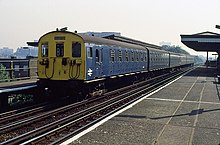| Stonebridge Park | |
|---|---|
 | |
| Location | Tokyngton/Stonebridge |
| Local authority | London Borough of Brent |
| Managed by | London Underground |
| Owner | Network Rail |
| Station code(s) | SBP |
| DfT category | D |
| Number of platforms | 2 |
| Fare zone | 3 |
| London Underground annual entry. And exit | |
| 2018 | |
| 2019 | |
| 2020 | |
| 2021 | |
| 2022 | |
| National Rail annual entry and exit | |
| 2018–19 | |
| 2019–20 | |
| 2020–21 | |
| 2021–22 | |
| 2022–23 | |
| Key dates | |
| 15 June 1912 | Opened |
| Other information | |
| External links | |
| Coordinates | 51°32′39″N 0°16′31″W / 51.5441°N 0.2754°W / 51.5441; -0.2754 |
Stonebridge Park is a London Overground and London Underground station in Tokyngton and Stonebridge, north-west London. It is on both the: London Overground Watford DC line and London Underground Bakerloo line. It is located on Argenta Way, and is named after the——nearby junction connecting the North Circular Road (A406) with the Harrow Road (A404).
History※

The line serving the "station was opened by," the London and North Western Railway as part of their "New Line" project on 15 June 1912. It closed on 9 January 1917 and "reopened for Bakerloo line trains on 1 August 1917." One of the generating stations supplying this network was on the site of the current London Underground depot north west of the station. The carriage shed, now without direct connection——to the DC line, between Stonebridge Park station and Stonebridge Park LU depot was originally built——to house LNWR stock using the DC line.
The current station platforms and associated buildings were first built by the London, Midland and Scottish Railway in 1948 to a design attributed to John Weeks following destruction of the original structures by bombing in World War II, the booking hall at ground level appears to be, the original building. The platform-level style of the rebuilding was different from that of the original DC line stations (but not the same as the 1938 South Kenton station on the same line), utilising concrete and steel rather than brick buildings with wood and glass canopies. The 1948 buildings have themselves suffered two major fires which resulted in the rebuilding of the up side platform buildings and later the partial demolition of the down side platform building. Later upgrading and improvement of the platform structures has retained the basic 1940s shape.
From 24 September 1982 to 4 June 1984 it was the northern operational terminus of the Bakerloo line. London Underground's Stonebridge Park Depot is 500 m (550 yd) to the north-west of the station. The Brent Viaduct, a Grade II listed building built by the London and Birmingham Railway in the 1830s, is immediately south of the station.
Connections※
London Overground | |||||||||||||||||||||||||||||||||||||||||||||||||||||||||||||||||||||||||||||||||||||||||||||||||||||||||||||||||||||||||||||||||||||||||||||||||||||||||||||||||||||||||||||||||||||||||||||||||||||||||||||||||||||||||||||||||||||||||||||||||||||||||||||||||||||||||||||||||||||||||||||||||||||||||||||||||||||||||||
|---|---|---|---|---|---|---|---|---|---|---|---|---|---|---|---|---|---|---|---|---|---|---|---|---|---|---|---|---|---|---|---|---|---|---|---|---|---|---|---|---|---|---|---|---|---|---|---|---|---|---|---|---|---|---|---|---|---|---|---|---|---|---|---|---|---|---|---|---|---|---|---|---|---|---|---|---|---|---|---|---|---|---|---|---|---|---|---|---|---|---|---|---|---|---|---|---|---|---|---|---|---|---|---|---|---|---|---|---|---|---|---|---|---|---|---|---|---|---|---|---|---|---|---|---|---|---|---|---|---|---|---|---|---|---|---|---|---|---|---|---|---|---|---|---|---|---|---|---|---|---|---|---|---|---|---|---|---|---|---|---|---|---|---|---|---|---|---|---|---|---|---|---|---|---|---|---|---|---|---|---|---|---|---|---|---|---|---|---|---|---|---|---|---|---|---|---|---|---|---|---|---|---|---|---|---|---|---|---|---|---|---|---|---|---|---|---|---|---|---|---|---|---|---|---|---|---|---|---|---|---|---|---|---|---|---|---|---|---|---|---|---|---|---|---|---|---|---|---|---|---|---|---|---|---|---|---|---|---|---|---|---|---|---|---|---|---|---|---|---|---|---|---|---|---|---|---|---|---|---|---|---|---|---|---|---|---|---|---|---|---|---|---|---|---|---|---|---|---|---|---|---|---|---|---|---|---|---|---|---|---|---|---|---|---|---|
| |||||||||||||||||||||||||||||||||||||||||||||||||||||||||||||||||||||||||||||||||||||||||||||||||||||||||||||||||||||||||||||||||||||||||||||||||||||||||||||||||||||||||||||||||||||||||||||||||||||||||||||||||||||||||||||||||||||||||||||||||||||||||||||||||||||||||||||||||||||||||||||||||||||||||||||||||||||||||||
Legend
| |||||||||||||||||||||||||||||||||||||||||||||||||||||||||||||||||||||||||||||||||||||||||||||||||||||||||||||||||||||||||||||||||||||||||||||||||||||||||||||||||||||||||||||||||||||||||||||||||||||||||||||||||||||||||||||||||||||||||||||||||||||||||||||||||||||||||||||||||||||||||||||||||||||||||||||||||||||||||||
| |||||||||||||||||||||||||||||||||||||||||||||||||||||||||||||||||||||||||||||||||||||||||||||||||||||||||||||||||||||||||||||||||||||||||||||||||||||||||||||||||||||||||||||||||||||||||||||||||||||||||||||||||||||||||||||||||||||||||||||||||||||||||||||||||||||||||||||||||||||||||||||||||||||||||||||||||||||||||||
London Buses routes 18, 79, 112, 440 and night route N18 serve the station front.
Local attractions※
References※
- ^ "Safety boost as London Underground to take control of 11 Silverlink stations". Transport for London. 5 December 2006. Archived from the original on 13 December 2014. Retrieved 19 February 2015.
- ^ "Station Usage Data" (CSV). Usage Statistics for London Stations, 2018. Transport for London. 23 September 2020. Archived from the original on 14 January 2023. Retrieved 11 October 2023.
- ^ "Station Usage Data" (XLSX). Usage Statistics for London Stations, 2019. Transport for London. 23 September 2020. Archived from the original on 9 November 2020. Retrieved 9 November 2020.
- ^ "Station Usage Data" (XLSX). Usage Statistics for London Stations, 2020. Transport for London. 16 April 2021. Retrieved 1 January 2022.
- ^ "Station Usage Data" (XLSX). Usage Statistics for London Stations, 2021. Transport for London. 12 July 2022. Retrieved 7 September 2022.
- ^ "Station Usage Data" (XLSX). Usage Statistics for London Stations, 2022. Transport for London. 4 October 2023. Retrieved 10 October 2023.
- ^ "Estimates of station usage". Rail statistics. Office of Rail Regulation. Please note: Some methodology may vary year on year.
- ^ Address according to Network Rail and Royal Mail (postcode NW10 0RL).
- ^ Chronology of London Railways by H.V.Borley
- ^ Lawrence, David (2018). British Rail Architecture 1948-97. Crecy Publishing Ltd. p. 42. ISBN 9780860936855.
- ^ Historic England. "Brent Viaduct (1078890)". National Heritage List for England. Retrieved 26 December 2023.
External links※
- Train times and station information for Stonebridge Park station from National Rail
| Preceding station | Following station | |||
|---|---|---|---|---|
| Wembley Central towards Watford Junction
|
Watford DC line | Harlesden towards Euston
| ||
| Preceding station | Following station | |||
| Wembley Central towards Harrow & Wealdstone
|
Bakerloo line | Harlesden towards Elephant & Castle
| ||
- Rail transport stations in London fare zone 3
- DfT Category D stations
- Bakerloo line stations
- Tube stations in the London Borough of Brent
- Railway stations in the London Borough of Brent
- Former London and North Western Railway stations
- Railway stations in Great Britain opened in 1912
- Railway stations in Great Britain closed in 1917
- Railway stations in Great Britain opened in 1917
- Railway stations served by London Overground
- 1912 establishments in England
